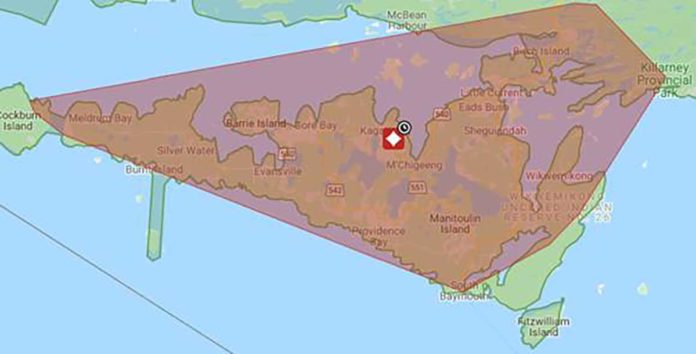MCGREGOR BAY – After a full season of monitoring Blanding’s turtles in McGregor Bay, researcher and McMaster University masters student Reta Meng is pleased with the data she and her team gathered despite the limitations imposed because of the pandemic. The data will be used to help with the conservation of Blanding’s turtles in the McGregor Bay and Whitefish River First Nation (WRFN) area.
“After this summer I have data on different types of habitats they’ve been using throughout the summer in McGregor Bay,” Ms. Meng said. “I’m going to use this data to analyze if they use a completely different type of habitat compared to other areas or if they perhaps use the same type of habitat. We don’t quite know yet but we’re starting to find that out with the data we’ve collected this summer.”
“Most other studies on Blanding’s turtles, which is a species at risk, are focused on a lot of other regions in Ontario including Algonquin, the Lake Erie area where the landscape is quite different. In McGregor Bay we see a lot of smaller islands with Canadian Shield geology which hasn’t been studied too well so we’re trying to see how that can impact the habitat use of Blanding’s turtles.”
Historically, Blanding’s turtles have occupied huge areas so they will cross over land—through forest, through wetlands—for kilometres at a time to get to a place they can nest and mate. What Ms. Meng found over the summer monitoring period is the McGregor Bay Blanding’s turtles don’t seem to be accessing a lot of further away islands as commonly as a turtle on a mainland area would be able to.
It’s possibly due to the many smaller islands and the fact that there is so much open. “That could be an implication that island populations might be particularly vulnerable to development because they’re not able to access other wetlands, either because they’re too far away and divided by huge amounts of open water, or the other islands are just way too small for them to live on,” she said. “If so, then this particular wetland that they’re living in would be extra important to protect. There’s implications of the importance of protecting certain wetlands and all sorts of different habitats and making sure that the habitat remains intact and remains healthy. That would be something that is extra important in the smaller island populations.”
McGregor Bay, specifically, is such a northern latitude that Blanding’s turtles are almost at their most northern extent. “The implications there are whether their active season would be a little bit shorter leading to much more time overwintering or hibernating in wetlands, and that could cause different behaviours,” explained Ms. Meng. “They’re really unique and special populations that we really want them to continue to do well in the area. I think that with a lot of the positive attitudes coming from WRFN and the cottagers’ association we will have prolonged success and a lot of engagement going forward as well.”
The research team engaged McGregor Bay Association cottagers and the lands department of the WRFN to assist with tracking. “Even though I wasn’t able to be there personally to help track during July and August we were still able to engage volunteers and incorporate community science,” she said. “It was a really great way to show people what we do and engage them. We were able to raise awareness about science, protecting a species at risk and how researchers do their work.”
It worked because many of the people in that area are naturally in tune with the environment and are all very proactive in terms of conservation to begin with, she said. “We could see they understood the work a little bit better and how we actually do the work to protect species at risk and as we tracked the different turtles through individual habitats, their understanding of what types of habitat the turtles used also increased. That will help everyone in the community understand where Blanding’s turtles might be and then maybe they will be a little bit more aware and slow down their boat or their car in those areas.”
Science has historically been a very inaccessible field but the increasing use of citizen or community science is a powerful tool that can lead to larger successes and bigger projects. Engaged local communities helps maintain the effectiveness of the research in the long term, Ms. Meng added. “We could just get the work done and publish a research paper but that’s not really an accessible format. These people are personally interacting with a species at risk and they’re the people that are living in the area that we want to protect. That’s much more powerful.” Engaged local community members are more likely to pass on that knowledge for generations.
For example, said Ms. Meng, “Alexis McGregor came out with us earlier on and was volunteering with us purely out of her own interest, with no previous experiences with the turtles. She went home and told her parents, her family and friends about what we did and now they’re all beginning to pay more attention to what species of turtles are there, whether they’re laying eggs, and considering different areas that they should be looking out for. The First Nations Lands Department that we worked with knew there have always been a lot of turtles in McGregor Bay and Birch Island but they treated them collectively as turtles. Now they’re seeing them as individual species, know which areas they nest in and ask how they can protect the nest.”
The McMaster team is feeling very appreciative about the positive attitudes and the amount of engagement received through just one single summer. “The McGregor Bay environment and Birch Island as well is a perfect example of how science can meet community engagement and that in turn can increase productivity of both efforts. It’s really made our research much more fun and much easier as well,” she said.
“We’re hoping that next year we’ll be able to expand the volunteer program even more and recruit more individuals that might be interested to come out with us and see what our work is like and then create long-term, sustainable conservation plans for these Blanding’s turtles so the entire community can embrace this conservation plan and after we’ve left the area that people still continue to make the effort to protect these species at risk,” said Ms. Meng.





